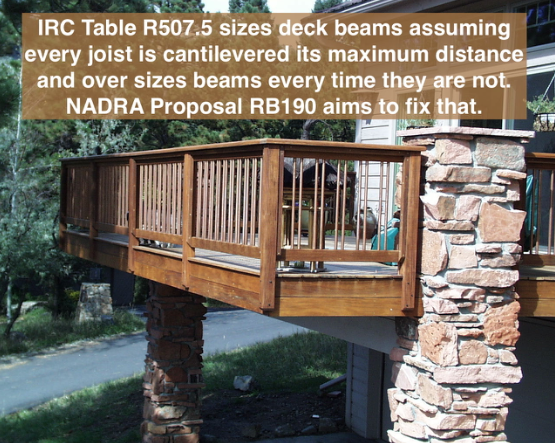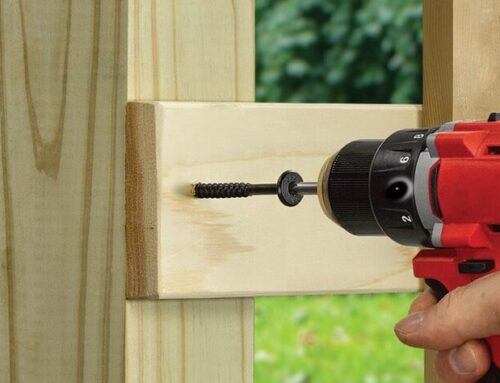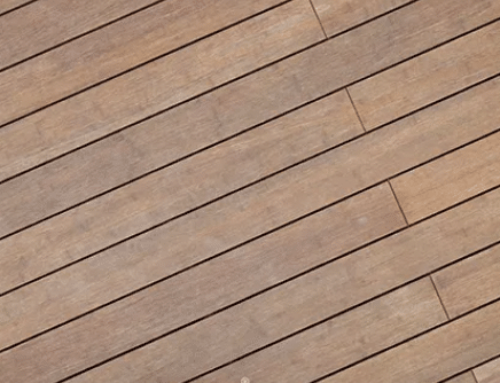August 14th, 2019
By: Glenn Mathewson
Proposal RB190 – Table R507.5
Through the efforts of NADRA.org and other organizations and professionals, the 2015 IRC revealed the first deck beam-sizing table (Table R507.5) to ever be included in a US model code. It provides maximum spans of simple deck beams based on different loading, species, profiles, and number of plies of common lumber. It was a welcome addition for building departments that have long struggled to approve deck designs without requiring an engineer and without having to develop their own span tables, as many had done. The American Wood Council (AWC) created their popular document, DCA6, to help alleviate this problem and provide pre-engineered design tables. These tables would become the 2015 provisions, and still today the AWC provides the engineering for most of the new deck structural provisions. For contractors working in regions not utilizing the DCA6, the new tables came as a little shock. In comparing the beams spans that have been acceptable, the new IRC tables cut them down dramatically. Why?
Creating a pre-engineered design table is not necessarily simple, specifically for beams. To provide a maximum allowable beam span, the load the beam is supporting has to be known. In its most simple form, a beam supports joists of the same length and carries half that length. A ledger, presumably, is carrying the other half. Those same joists, however, could cantilever beyond the beam, and the beam would support the entire load of the cantilever. This is just one design variable of many. A beam could be at an angle and support a non-uniform load along its length, or it could be supporting joists spanning from both sides. Currently none of those variables are provided in the code.

Why did many allowable beam spans suddenly reduce with the new code? The table is calculated on the assumption that every beam is supporting maximum-cantilevered joists. In many cases, joists can cantilever beyond the beam up to 1/4 their span, and that’s a lot of added load…load that is being designed for every time, whether there or not. Consider a deck with a 12 ft. joist span and no cantilever. The beam is actually carrying 6 feet of joist, but the code is sizing it as if it’s carrying 9 ft., because it’s assuming the maximum allowable 3 ft. joist cantilever is there. If you did cantilever the joist the maximum distance, the table is accurate. If you didn’t, your beam spans are unnecessarily restricted…significantly. Okay—Let’s fix that!
The NADRA proposal RB190 adds a footnote to the beam span table with a set of modifiers. The modifiers allow you to alter the input “joist span” in the beam span table based on different percentages of joist cantilever from zero to one-fourth. Included are cantilevers of 1/12, 1/10, 1/8, 1/6, and the maximum 1/4 of the joist span. Currently, a (2) 2×10 southern pine beam supporting a 12 ft. joist span is restricted 7 ft. – 4 in., REGARDLESS of whether the joists cantilever or not. With RB190’s modifiers, if the joists don’t cantilever, the 12 ft. span can be multiplied by .66 to yield an equivalent span of 8 ft. Using this value in the table results in an accurate maximum beam span of 9 ft. That’s no small margin from the current 7 ft. – 4 inch maximum! There is no reason not to allow beams to be sized for their actual loads, and possibly reduce some costs or visually obstructive posts from our neighbors’ backyards.
Proposal RB190 was prompted by NADRA, developed with the help of the Deck Code Coalition, and engineered by the American Wood Council. It is solid engineering in a solid concept. It was approved at the Committee Action Hearings with no opposition. There is good reason to believe it will make it through the last part of the ICC code development process, the Final Action Hearing.
Please support proposal RB190 and let’s maintain an appropriate balance between safety, design freedom, and affordability.
Please contact NADRA for any questions or concerns regarding this proposal. We welcome your conversation. You can send an email to Info@NADRA.org




